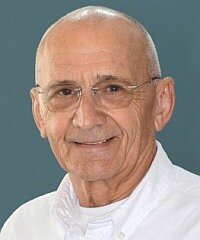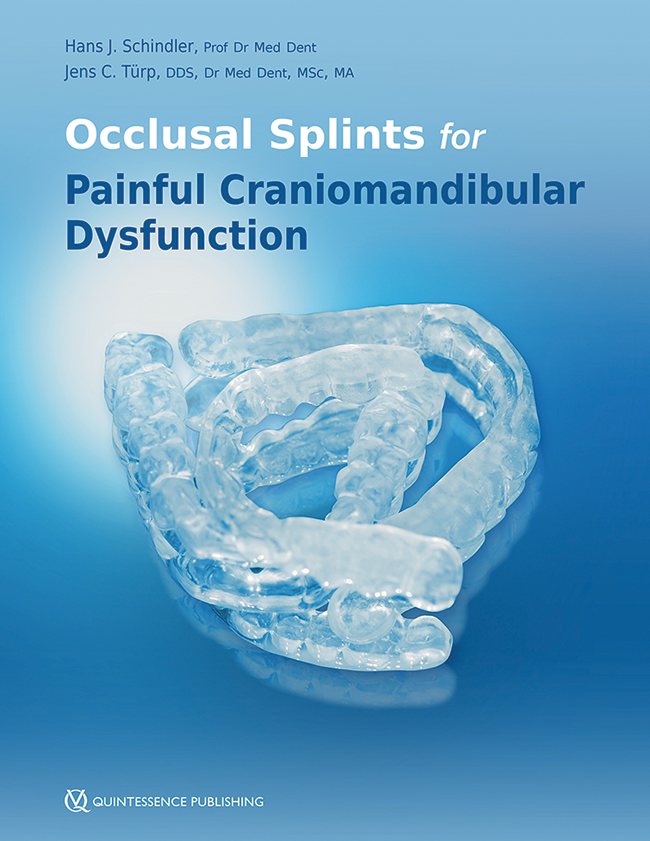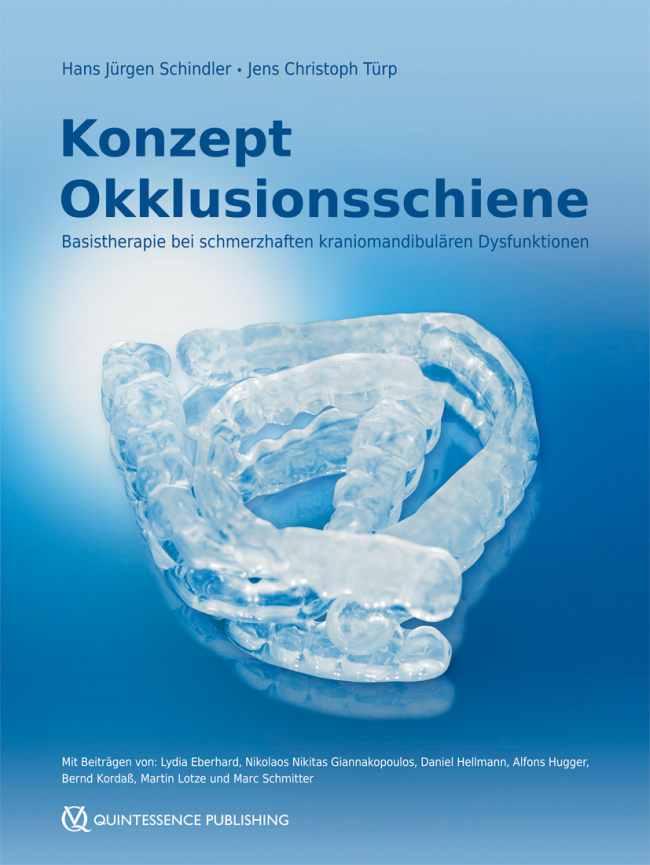Journal of Craniomandibular Function, 1/2024
SciencePages 9-28, Language: English, GermanObid, Nada / Frommer, Vivien / Huber, Christoph / Schindler, Hans Jürgen / Schmitter, Marc / Giannakopoulos, Nikolaos NikitasIntroduction: Self-report of awake or sleep bruxism (AB/SB) has been the subject of critical scrutiny, as it is yet unclear whether it corresponds to the neurophysiological bruxism activity. Contingent electrical stimulation (CES) has been proposed as a possible treatment that reduces bruxism episodes. The aim of this cohort study was to investigate whether bruxism self-report is influenced by CES.
Methods: Forty healthy adults were allocated to the intervention (N = 20) or control group (N = 20). Each participant filled out the Oral Behavior Checklist (OBC) and an anamnestic questionnaire including questions on bruxism behavior, at the beginning and at the end of the study. The evaluation period was divided into three GrindCare intervals (1 inactive week -2 active CES weeks/ 2 inactive weeks -2 inactive weeks). The OBC score and the amount of positive and negative bruxism answers were compared with baseline using the Wilcoxon test and the McNemar (McN) test.
Results: The OBC score/categories and the self-report of AB/SB did not significantly change (p > 0.05), indicating no effects of CES in the intervention group.
Conclusions: Within the scope of this study, CES could not significantly improve the self-report of bruxism or bruxism-related symptoms. However, it is recommended that the study be repeated with the study design extending the CES intervention to a longer interval and with a larger sample size.
Keywords: bruxism, electrical stimulation, self-report, diagnosis, questionnaires
Journal of Craniomandibular Function, 2/2023
SciencePages 101-117, Language: English, GermanFrommer, Vivien / Obid, Nada / Huber, Christoph / Schmitter, Marc / Schindler, Hans Jürgen / Giannakopoulos, Nikolaos NikitasPurpose: This study compared different methods of bruxism diagnosis used in clinical practice. The purpose of this study was to investigate the agreement between two diagnostic tools for bruxism (questionnaires and portable EMG measuring device).
Methods: Seventy-six (76) subjects without craniomandibular dysfunction (CMD) were examined for their bruxism behavior in a clinical study over an observation period of 5 weeks. Measurements of episodes per hour were performed in the home setting using the GrindCare (GC) portable EMG device. The period was divided into 3 intervals (1 week – 2 weeks – 3 weeks). A minimum of 5 h of recorded sleep was a prerequisite for all participants. In addition, sleep (SB) and awake bruxism (AB) self-reports were collected at baseline and the end of the study using questionnaires, including the Oral Behavior Checklist (OBC).
Results: There is a significant correlation between increased jaw activity (diagnosed by OBC) and SB/AB self-reports, as well as between SB and AB self-reports, but not between questionnaires and instrumental (GC) diagnostics.
Conclusion: Questionnaires cannot replace EMG measurements in bruxism diagnostics. Dentists should always use a combination of self-reports in the form of validated questionnaires and instrumental diagnostics to detect bruxism.
Keywords: teeth grinding, diagnostics, sleep bruxism, awake bruxism, electromyography
Journal of Craniomandibular Function, 4/2021
SciencePages 295-317, Language: English, GermanStimmer, Magdalena / Giannakopoulos, Nikolaos Nikitas / Held, Helena / Schindler, Hans Jürgen / Roldán-Majewski, CarolinaPartial results of a systematic review and meta-analysisIntroduction: This article reports the results of a comprehensive systematic review and meta-analysis of the effect of occlusal splints (OSs) on active maximum mouth opening (AMMO) in patients with temporomandibular disorders (TMD).
Methods: Multiple databases (PubMed/MEDLINE, EMBASE, Cochrane Library, LIVIVO, OpenGrey, DRKS, and ClinicalTrials.gov) plus additional literature were searched for relevant randomized clinical trials (RCTs) using OSs to treat adults with painful TMD. AMMO was assessed after 6 and 12 months of treatment, and OS therapy was compared with no treatment, other active treatments (OATs), and/or placebo splints. The Cochrane Collaboration’s tool for assessing risk of bias was used to assess study quality. The threshold for statistical significance of correlations detected by meta-analysis was P ≤ 0.05.
Results: The use of OSs did not increase AMMO significantly more than no treatment (P = 0.28) or placebo splints (P = 0.76). OS therapy was significantly inferior to OATs (P = 0.02 for short-term effect, P = 0.01 for medium-term effect). In 18 of the 21 included studies, OSs increased AMMO slightly but not significantly more than no treatment (P = 0.28) or placebo splints (P = 0.76).
Conclusions: OSs made no significant contribution to improving AMMO. Therefore, OATs should be used in patients with limited jaw opening.Registration: This study was registered in the PROSPERO database under ID number CRD42019123169.
Keywords: temporomandibular disorders (TMD), systematic review, meta-analysis, adults, pain propagation, occlusal splints, pain chronification
Journal of Craniomandibular Function, 3/2018
Pages 239-248, Language: English, GermanKravchenko-Oer, Alexandra / Koch, Mara / Nöh, Kristina / Ostermann, Charlott / Winkler, Luzie / Kordaß, Bernd / Hugger, Sybille / Schindler, Hans Jürgen / Hugger, AlfonsThe aim of this study was to analyze the effect of occlusal modifications on the muscular activity of the masseter and anterior temporalis muscles. The study included 41 healthy dentate subjects who were examined in relation to the muscle activity of the masseter and anterior temporalis muscles recorded by surface electromyography (EMG) bilaterally in two different sessions. Occlusal plastic strips (thickness: 0.4 or 0.8 mm) were placed on different mandibular teeth to simulate different bite constellations (unilateral, bilateral transversal, and bilateral diagonal). Controlled by visual feedback, the subjects performed submaximum occlusion at 10% and 35% of maximum voluntary contraction (MVC). The activity ratios of the muscles were analyzed by two-way repeated measurement analysis of variance (ANOVA), and the reliability of muscle activity data was determined by intraclass correlation coefficient (ICC) analysis. The activity ratios of the masseter muscles were not significantly different under various biting conditions. In contrast, the anterior temporalis muscles showed significant differences (P 0.001) between unilateral configurations and the other biting conditions (bilateral transversal or diagonal), in particular during biting at 10% MVC. In general, ICC values revealed low to moderate reliability of the measurements of muscle activity. Under controlled submaximum occlusal loading, the activity behavior of the masseter muscles remained stable, whereas the anterior temporalis muscles reacted differently to distinct occlusal biting configurations. The results support the assumption that the anterior temporalis muscles might operate as fine-tuning muscles when asymmetric bite force distributions occur, for instance during chewing, caused by food fragments between the teeth.
Keywords: activity ratio, clenching, electromyography (EMG), masticatory muscles, occlusal interference, occlusal modification, visual feedback
International Journal of Computerized Dentistry, 1/2018
PubMed ID (PMID): 29610777Pages 17-22, Language: English, GermanKravchenko-Oer, Alexandra / Koch, Mara / Nöh, Kristina / Osterman, Charlott / Winkler, Luzie / Kordaß, Bernd / Hugger, Sybille / Schindler, Hans Jürgen / Hugger, AlfonsThe aim of this study was to analyze the effect of occlusal modifications on the muscular activity of the masseter and anterior temporalis muscles. The study included 41 healthy dentate subjects who were examined in relation to the muscle activity of the masseter and anterior temporalis muscles recorded by surface electromyography (EMG) bilaterally in two different sessions. Occlusal plastic strips (thickness: 0.4 or 0.8 mm) were placed on different mandibular teeth to simulate different bite constellations (unilateral, bilateral transversal, and bilateral diagonal). Controlled by visual feedback, the subjects performed submaximum occlusion at 10% and 35% of maximum voluntary contraction (MVC). The activity ratios of the muscles were analyzed by two-way repeated measurement analysis of variance (ANOVA), and the reliability of muscle activity data was determined by intraclass correlation coefficient (ICC) analysis. The activity ratios of the masseter muscles were not significantly different under various biting conditions. In contrast, the anterior temporalis muscles showed significant differences (P 0.001) between unilateral configurations and the other biting conditions (bilateral transversal or diagonal), in particular during biting at 10% MVC. In general, ICC values revealed low to moderate reliability of the measurements of muscle activity. Under controlled submaximum occlusal loading, the activity behavior of the masseter muscles remained stable, whereas the anterior temporalis muscles reacted differently to distinct occlusal biting configurations. The results support the assumption that the anterior temporalis muscles might operate as fine-tuning muscles when asymmetric bite force distributions occur, for instance during chewing, caused by food fragments between the teeth.
Keywords: activity ratio, clenching, electromyography (EMG), masticatory muscles, occlusal interference, occlusal modification, visual feedback
Journal of Craniomandibular Function, 3/2015
Pages 183-186, Language: English, GermanSchindler, Hans Jürgen






